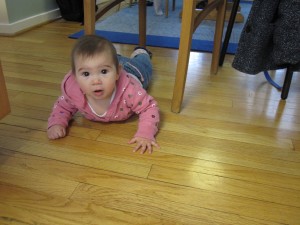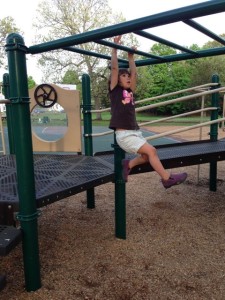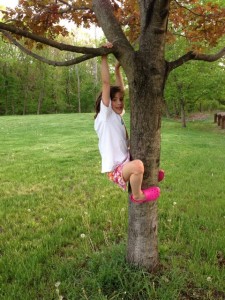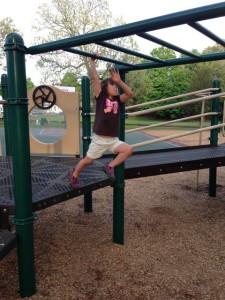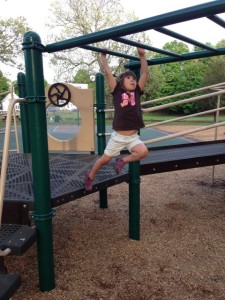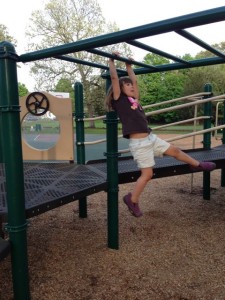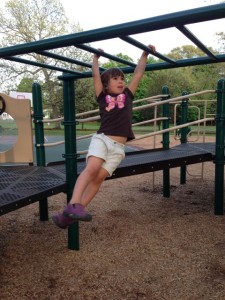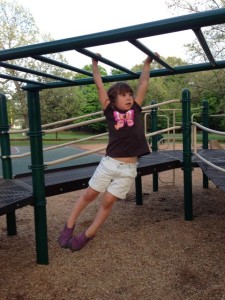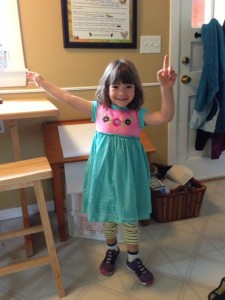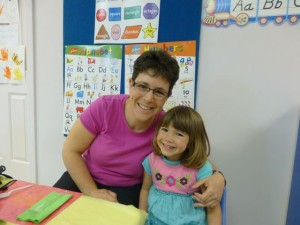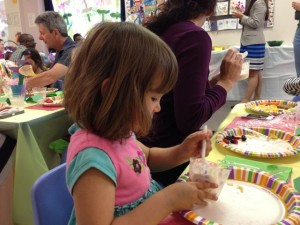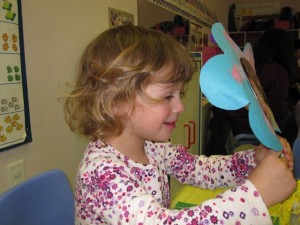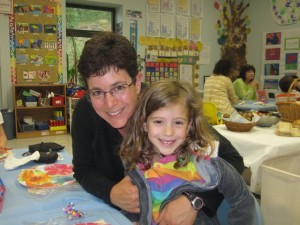This post is part of my streak of posts in the month of May to spread awareness about pediatric stroke. Please consider donating to support Children’s Hemiplegia and Stroke Association, an organization that has helped our family with support and information.
When 8-month-old Mia started to crawl with her right hand fisted, it was unclear when she’d be able to open that hand consistently and at will, unclear that a month before turning 4-years-old, she’d be able to teach herself to swing like a monkey. But, here she is doing that. I think neuroplasticity can explain it, and all the supports that I have put in place for Mia to continue to learn.
My own journey with neuroplasticity began more than 20 years ago when I first experienced the Feldenkrais Method® via an Awareness Through Movement® class in La Jolla, California. Moshe Feldenkrais was way ahead of his time, inventing a method to rehabilitate his knee based on his knowledge of physics, judo, and his observations of how babies naturally learn and develop. He soon found applications for all kinds of people of all ages who wanted to improve their functioning. I went to that same class every Thursday at 6 pm for six years all through graduate school and my postdoc. I went initially to help heal a shoulder injury suffered shot putting in high school and exacerbated by playing varsity ice hockey in college. I kept going because the lessons taught me something about myself, about going at a pace that was not my habit. I moved to Ann Arbor, had enough disposable income to seek private Functional Integration® lessons. After a year, I moved to Massachusetts where I still live and once again, I sought out new practitioners. After a few years, I still couldn’t get enough so I entered a professional training program in New York City for four years in the Feldenkrais Method.
It’s as if my apprenticeship in the Feldenkrais Method perfectly prepared me to parent Mia with acute mindfulness about her development and the power of neuroplasticity that modern science is now substantiating in concrete ways.
Through Children’s Hemiplegia and Stroke Association, I am part of a mailing list for families of “Hemi-Kids” – that is children who have impaired use of one side of their bodies. This week, on the Hemi-Kids list, I read of Karen Pape, a neonatologist who has a very progressive approach towards treating children who had early neurological problems. She has a fascinating Ted talk on her site.
Pape’s ideas are completely aligned with those of Moshe Feldenkrais and with how I have been parenting Mia and advocating for her for nearly four years. Habits can get in the way of better functioning and the best way to shake up habits to retrain the brain is to introduce novelty in a challenging situation where some focus is required. In Pape’s Ted talk, she shows a little girl reaching above her head with both arms while standing. She has difficulty doing so fully with her left arm. But, when asked to do jumping jacks, the extension is much more complete and natural. When I saw that, I was immediately reminded of Mia’s monkey bar adventures from last Friday when I captured her extending her right arm beautifully to accomplish her own self-defined goal of mastering the monkey bars.
Zoe is 6 and Mia is nearly 4 and so Zoe has a lot more questions about Mia’s differences than Mia does at this point. In a recent conversation, Zoe stated, “Mia has had two things wrong with her body, her ears and her righty.” As a baby, Mia had recurrent ear infections, ear tubes, and recently a procedure to remove the one tube that didn’t fall out on its own. I reframed for Zoe and for Mia who was in the car too. I offered, “There’s nothing wrong with Mia’s right arm or hand. She had a stroke near birth and that injury in her brain means she needs to work a bit harder and smarter to learn to use righty.”
Pape asserts that baby brains recover better than adult brains in rats and monkeys and she thinks humans too, though not enough research has been done to fully validate the human conclusion. I believe it to be true too since young brains start out as a tabula rasa. Pape’s vision of continual improvement being possible is consistent with my view that the sky is the limit for Mia’s functioning and potential. One of my favorite Feldenkrais quotes goes something like this, “Make the impossible possible, the possible easy, and the easy elegant.”

